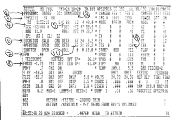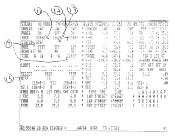



Next: 4.4 Spacecraft Constraints
Up: 4 Observing at GSFC
Previous: 4.2 Observing Scripts
In addition to the color image display, the Telescope Operator uses four
video display pages to monitor the scientific instrument and ground system.
Two consoles may select any of over two dozen pages. They usually display the
Attitude Control System (ACSM2) page (telemetry associated with spacecraft
pointing and maneuvering) and the EVENT page (current activities of the ground
command computer and procedure execution). The science operations,
displayed on two
pages, is displayed all the time and contains information on the scientific
instrument, including the FES, spectrographs, and cameras. Some of this
information may prove useful to you during the shift. This Section describes
the more important items on the SIFES1 and SICAM1 pages (see Figure 4.3 and 4.4).
The RA and TO are always available to help you interpret the display.
 Figure 4.3.
Figure 4.3.
SIFES1 page:
- (1)
- The five-letter observing program identification code.
- (2)
- The observer's name.
- (3)
- The target name currently loaded in the ground computer.
- (4)
- The coordinates of a loaded target or an offset star. Note that this
is not necessarily the target at which the spacecraft is currently
pointing. This position is used to calculate maneuvers. Items 1-4 are
archived with the spectral data in the image header (see Section 4.14).
- (5)
- The current attitude of the IUE. RA and DEC are both given in
degrees. The spacecraft roll determines the orientation of the field as
seen by the FES (see Section 3.8).
- (6)
- The current location of the target. (LWLA = long wavelength, large
aperture; SWSA = short wavelength, small aperture; RPNT = reference
point).
- (7)
- The Flux Particle Monitor (FPM) radiation level (not in use).
- (8)
- The most recently computed telescope focus "step" (see
Section 4.10).
- (9)
- The FES counts of the object currently being tracked by the FES.
This is usually the target if an exposure is being set up, or the guide
star if an exposure is in progress.
- (10)
- The Beta angle as determined from the Fine Sun Sensor on the
spacecraft.
 Figure 4.4.
Figure 4.4.
SICAM1 page:
- (11)
- The LWP camera image number. Note that it is incremented after
camera read is started.
- (12)
- The SWP camera image number. As for the LWP, this is for the
last
image read.
- (13)
- The LWR camera image number. As for the LWP, this is for the
last
image read.
- (14)
- The camera status and remaining exposure time. The LWP camera is
standard "prepped" and in standby mode. The SWP camera is
exposing, with 114 minutes and 7 seconds remaining in the exposure.
- (15)
- The current dispersion modes of the spectrographs are shown. The
long-wavelength spectrograph is in high dispersion while the
short-wavelength spectrograph is in low dispersion.




Next: 4.4 Spacecraft Constraints
Up: 4 Observing at GSFC
Previous: 4.2 Observing Scripts
Last updated: 24 July 1997
jrc
 Figure 4.3.
Figure 4.3.